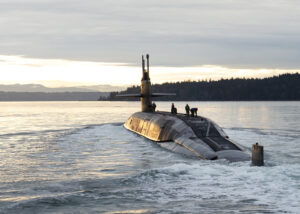The Navy recently completed the last scheduled Engineered Refueling Overhaul (ERO) of an Ohio-class nuclear-armed ballistic missile submarine with the USS Louisiana
(SSBN-743), the service said Wednesday.
SSBN-743 ERO project superintendent Ken Rogers said this 40-month availability was the biggest repair package in ERO history, covering over 870,000 resource days of work. The work was focused at the Puget Sound Naval Shipyard and Intermediate Maintenance Facility (PSNS & IMF) in Bremerton, Wash., and was completed on Feb. 21.

SSBN-743 first docked at PSNS&IMF in September 2019 for what was supposed to be a two and a half year ERO until various delays, including those caused by the COVID-19 pandemic, changed the timeline.
In December 2021, Rogers said the ERO was then due to be complete by fall 2022. At the time they were tracking almost 6.5 million man-hours and 95 percent of the work was finished as the submarine undocked.
“The Louisiana ERO was tasked to complete 120,000 more resource days of work than the USS Nebraska (SSBN-739) ERO and 150,000 more resource days of work than the USS Maine (SSBN-741) ERO. Additionally, the length of Louisiana’s ERO was impacted by the COVID-19 pandemic and unexpected new work items that included an unprecedented repair to a communication system,” Rogers said.
The ERO work included nuclear reactor refueling, overhauling or replacing major components in the submarine like the shaft, inspecting and repairing tanks, installing the Submarine Warfare Federated Tactical System, upgrading other electronic systems and the control station and radio room, configuring living spaces for enlisted women, and conducting routine inspections and repairs on the boat.
In 2021, the Navy noted some of its previous lessons learned for this work included taking a systems approach to hydraulic, mechanical and electrical testing and undocking readiness.
Aside from the refueling work, the combined project team of PSNS & IMF workers, Ship’s Force, and contractors also configured living spaces for enlisted women, overhauled or replaced major components within the submarine, upgraded electronic systems, and conducted routine inspections and repairs throughout the boat.
Rogers argued a good working relationship among PSNS & IMF workers, ship’s force and contractors helped ensure team successes.
“The ship’s commanding officer, Cmdr. Mike Kessler, and I were completely aligned on goals, metrics and manning requirements to support all the work. I greatly appreciate his partnership during the ERO,” he said.
In 2020, Rear Adm. Ed Anderson, then-commander of undersea warfare, said SSBN-743’s ERO included a diesel generator renewal . The nuclear-powered SSBNs include diesel systems as backups if they have to shut down the reactor (Defense Daily, Nov. 19, 2020).
Anderson said the Navy’s experience with refueling and extending the life of Los Angeles-class attack submarines fed into work on the SSBNs as well.
“We’ve learned a lot about how we should be operating them better, how we should maintain them better, how we can get predictive with that very old technology – we can use data with those too. And we’re improving those to the point of we’re doing a renewal of every SSBN diesel engine as every [ballistic missile submarine] comes through its last major availability,” he said.